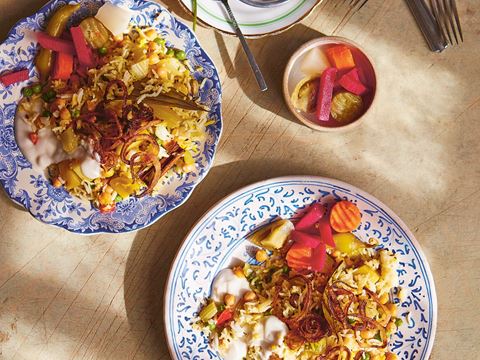
AramcoWorld: Covering 75 Years of Global Food Culture
From the ancient world to modern main courses, AramcoWorld’s vivid cover stories highlighting diverse dishes offer readers an opportunity to dig into a variety of recipes and how culinary traditions defined cultures.
Through family gatherings and other festive celebrations, food creates connections and lasting memories. AramcoWorld seeks to satiate readers with insight into rich and diverse culinary traditions served up on a plate—or banana leaf.
We not only highlight recipes but the stories behind them, the people who create them and the cultures they represent—as captured on our iconic covers.
Visual feasts in their own right, our covers chronicle the transformation of global cuisines, food migrations and sustainability.
“Couscous: The Measure of the Maghrib” (1998), for example, looked at the region where the staples of rice and couscous meet.
In 2021 we took readers around the world through their spice racks with “Spice Migrations” to provide context for some of the world’s favorite spices, including cinnamon, cumin and ginger. The series explored the Indian origins and migration to Europe and Africa of the most common spice on our tables, pepper.
The intersection of food and history also has been demonstrated. “Ghraoui and the Chocolate Factory” (2008) showed how a Syrian chocolatier, whose family had been in the business for more than 100 years, was further putting his country on the map as having the world’s best chocolate. We devoted the entire issue “Flavors of the Middle East” (1988) to recipes from clay tablets in 1700 BCE to modern starters, main courses and desserts from the region.
AramcoWorld has reflected on the ways food shapes culture and heritage through stories like 1962’s “Oasis Fruit,” which referred to the date palm as the “tree of life” for people in the Middle East. Sustainability efforts for local ingredients have received stark spotlights, as in “Harvest Without End” (1960), in which we showed how modern methods at the time helped Saudi Arabian farmlands bloom again. We also highlighted scientific efforts to address food security and innovations in “Seeds of High Asia” (2012) and “Can Figs Help Us Adapt to a Changing Climate?” (2024).
As AramcoWorld commemorates 75 years, we celebrate our commitment to showcasing the beauty and diversity of food from around the world and its role in bringing people together through a shared love of culinary exploration. We also remain committed to raising cross-cultural understanding through stories that are globally interconnected.

Left to right: This 1978 special issue highlighted agriculture practices from Syria to Sudan. May/June 1978, “Farming in the Middle East” (Illustration by Norman MacDonald) • The vibrant colors of this 2014 cover share the love of chiles that have transforming nutritional values and have enhanced culinary identities across the globe. March/April 2014, “Chiles’ Global Warming” (Photo by Deana Sidney)

Left to right: November 1960’s “Harvest Without End” highlights how innovative methods bring fresh produce to local markets daily in the 1960s. (Photo by B. H. Moody) April 1954, “Where old friends meet” (Photo courtesy of Standard Oil Company) July 1959, “Your cup of tea” (Photo by Ewing Galloway) November 1958, “The Turkey: Bird of Thanksgiving” (Photo by Frederic Lewis) November 1959, “Sweet as Apple Cider” (Photo by Ewing Galloway)

Left to right: The Maghrib, a region made up of present-day Morocco, Algeria, Libya and Tunisia, boasts a variety of culturally rich foods, that AramcoWorld has featured over the years. November/December 1998, “Couscous: The Measure of the Maghrib” (Photo by Owen Morse) January 1953, “Bread: The World’s Food” (Photo by T. F. Walters) September/October 1995, “On the Flatbread Trail” (Photo courtesy of Asia Access Photo Agency)

Left to right: January/February 1997, “Memories of a Lebanese Garden” (Illustration by Linda Dalal Sawaya) May/June 1978, “Farming in the Arab East” (Illustration by Norman MacDonald) In 2021 AramcoWorld took readers on a journey through their kitchen spice rack sharing the history of six spices, illustrated above right: Cinnamon, Pepper, Ginger, Cumin, Cloves and Nutmeg. (Illustration by Linda Dalal Sawaya) January/February 2021, “Spice Migrations: Cinnamon” (Illustration by Linda Dalal Sawaya)

Left to right: At the time of the article Al-Hasa, known as Hajar in ancient times, covered about 20,000 hectares (50,000 acres) and was said to be the largest date palm oasis in the world. July/August 2004, “Carrying Dates to Hajar” (Photo by Eric Hansen) November 1956, “Souvenir of a visit to the country” (Photo by T. F. Walters) March 1962, “Oasis Fruit” (Illustration by Walter Ferro)

Left to right: The Middle East’s ancient trade, rich flavors and generational traditions have created a cultural bridge with the West. March/April 1988, “‘The Flavors of Arabia” (Photo by Christopher D. Salvo) November/December 2008, “Ghraoui and the Chocolate Factory” (Photo by Tor Eigeland) July/August 2003, “Zalabia and the first Ice-Cream cone” (Photo by David Alan Harvey)

Left to right: Innumerable variations in craft, cuisine, spice and scent distinguish Saudi Arabia’s southwestern Asir province, where traditional markets were held in each regional center on a different day of the week. Among them, the Tuesday market in Abha, the province capital, is one of the most colorful. July/August 1998, “The Suqs of Asir” (Photo by Peter Sanders) January/February 1996, “Culinary Reconnaissance: Indonesia” (Photo by Brynn Bruijn) March/April 2018, “Marseille’s Migrant Cuisine” (Photo by Rebecca Marshall) Using their local ingredients, generations of women in Pakistan’s northernmost valley developed a remarkably imaginative culinary repertoire. Some 25 women pooled their talents to produce the first-ever Hunza recipe book, which features a recipe of Sultan Qoq, one of the few sweets in the Hunza Valley cuisine. It is made using apricot kernels, walnuts, dried mulberries and water. May/June 2006, “Cooking in Hunza” (Photo by Matthieu Paley)

Left to right: A spotlight on local farmers as they preserve ancient rye for future global crops. January/February 2012, “Seeds of High Asia” (Photo by Matthieu Paley) March/April 2024, “Can Fig Trees Help Us Adapt To A Changing Climate?” (Photo by Rebecca Marshall)
You may also be interested in...

How a Quest To Perfect Butter Chicken Rekindled Memories and Heritage
Food
What begins as a lesson in a beloved recipe becomes a journey through diaspora, friendship and the scents that tie us to places we’ve never lived.
Recipe for Fennel and Potato Biryani
Food
Biryani is a whole and very elaborate genre of rice dishes, not be confused with pulao or pilaf.
Bengali Snack: Potato Chops Recipe
Food
The Bengalis are famous for their “chops,” or potato croquets eaten as snacks with tea.